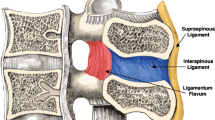Abstract
The normal range of motion (ROM) of the sacroiliac joint (SIJ) has been measured in various ways and has been found to be minimal under normal conditions (Buchowski et al., Spine J 5:520–528, 2005; Foley and Buschbacher, Am J Phys Med Rehabil 85:997–1006, 2006; Katz et al., J Spinal Disord Tech 16:96–99, 2003; Walker, Phys Ther 72:903–916, 1992). There are clinical situations where the SIJ has been “out of alignment” or has been “realigned” by the clinician based on external anatomical clinical findings. Controversy continues to exist regarding SIJ ROM in terms of stability in both clinical and surgical situations. This chapter discusses what happens to the ROM of the SIJ when the posterior supporting ligament structures are sequentially transected after which adjacent joint (L5–S1) stabilization is performed. Clinical relevance is then discussed based on these findings.
Access this chapter
Tax calculation will be finalised at checkout
Purchases are for personal use only
Similar content being viewed by others
References
Buchowski JM, et al. Functional and radiographic outcome of sacroiliac arthrodesis for the disorders of the sacroiliac joint. Spine J. 2005;5:520–8. discussion 529.
Foley BS, Buschbacher RM. Sacroiliac joint pain: anatomy, biomechanics, diagnosis, and treatment. Am J Phys Med Rehabil. 2006;85:997–1006.
Katz V, Schofferman J, Reynolds J. The sacroiliac joint: a potential cause of pain after lumbar fusion to the sacrum. J Spinal Disord Tech. 2003;16:96–9.
Walker JM. The sacroiliac joint: a critical review. Phys Ther. 1992;72:903–16.
Wilke HJ, Wenger K, Claes L. Testing criteria for spinal implants: recommendations for the standardization of in vitro stability testing of spinal implants. Eur Spine J. 1998;7(2):148–54.
Goel VK, et al. Test protocols for evaluation of spinal implants. J Bone Joint Surg Am. 2006;88 Suppl 2:103–9.
Panjabi MM. Hybrid multidirectional test method to evaluate spinal adjacent-level effects. Clin Biomech (Bristol, Avon). 2007;22(3):257–65.
Agarwala A, et al. Do facet screws provide the required stability in lumbar fixation? A biomechanical comparison of the Boucher technique and pedicular fixation in primary and circumferential fusions. Clin Biomech (Bristol, Avon). 2012;27(1):64–70.
Beutler WJ, et al. A biomechanical evaluation of a spacer with integrated plate for treating adjacent-level disease in the subaxial cervical spine. Spine J. 2012;12(7):585–9.
Durrani A, et al. Could junctional problems at the end of a long construct be addressed by providing a graduated reduction in stiffness? A biomechanical investigation. Spine (Phila Pa 1976). 2012;37(1):E16–22.
Lee JK, et al. In vitro biomechanical study to quantify range of motion, intradiscal pressure, and facet force of 3-level dynamic stabilization constructs with decreased stiffness. Spine (Phila Pa 1976). 2013;38(22):1913–9.
Majid K, et al. The biomechanical effect of transverse connectors use in a pre- and postlaminectomy model of the posterior cervical spine: an in vitro cadaveric study. Spine (Phila Pa 1976). 2011;36(26):E1694–701.
Frymoyer JW, Howe J, Kuhlmann D. The long term effects of spinal fusion on the sacroiliac joints and ilium. Clin Orthop. 1978;134:196–201.
Onsel C, Collier BD, Kir KM, Larson SJ, et al. Increased sacroiliac joint uptake after lumbar fusion and/or laminectomy. Clin Nucl Med. 1992;17(4):283–7.
Schoenfeld AJ. Adjacent segment degeneration after lumbar spinal fusion: risk factors and implications for clinical practice. Spine J. 2011;11(1):21–3.
Kim TH, Lee BH, Moon SH, Lee SH, Lee HM. Comparison of adjacent segment degeneration after successful posterolateral fusion with unilateral or bilateral pedicle screw instrumentation: a minimum 10-year follow-up. Spine J. 2013;13(10):1208–16.
Radcliff KE, Kepler CK, Jakoi A, Sidhu GS, Rihn J, Vaccaro AR. Adjacent segment disease in the lumbar spine following different treatment interventions. Spine J. 2013;13(10):1339–49.
Kharrazi FD, Rodgers WB, Kennedy JG, Lhowe DW. Parturition induced pelvic dislocation: a report of four cases. J Orthop Trauma. 1997;11(4):277–81.
Vleeming A, Buyruk HM, Stoeckart R, Karamursel S, Snijders CJ. An integrated therapy for peripartum pelvic instability: a study of the biomechanical effects of pelvic belts. Am J Obstet Gynecol. 1992;166(4):1243–7.
Zelle BA, Gruen GS, Brown S, George S. Sacroiliac joint dysfunction: evaluation and management. Clin J Pain. 2005;21(5):446–55.
Albert H, Godskesen M, Westergaard J. Prognosis in four syndromes of pelvic related pain. Acta Obstet Gynecol Scand. 2001;80(6):505–10.
Berg G, Hammar M, Moller-Nielsen J. Low back pain during pregnancy. Obstet Gynecol. 1998;71(1):71–5.
Waisbrod H, Kraninick JU, Gerbergshagen HU. Sacroiliac joint arthrodesis for chronic lower back pain. Arch Orthop Trauma Surg. 1987;106:238–40.
Belanger TA, Dall BE. Sacroiliac arthrodesis using posterior midline fascial splitting approach and pedicle screw instrumentation: a new technique. J Spinal Disord. 2001;14:118–24.
Wise CL, Dall BE. Minimally invasive sacroiliac joint arthrodesis: outcomes of a new technique. J Spinal Disord Tech. 2008;21:579–84.
Author information
Authors and Affiliations
Corresponding author
Editor information
Editors and Affiliations
Rights and permissions
Copyright information
© 2015 Springer International Publishing Switzerland
About this chapter
Cite this chapter
Dall, B.E., Eden, S.V., Bucklen, B., Moldavsky, M., Mcnutt, R.W. (2015). Biomechanics of the Injured SIJ: Results from an In Vitro Study. In: Dall, B., Eden, S., Rahl, M. (eds) Surgery for the Painful, Dysfunctional Sacroiliac Joint. Springer, Cham. https://doi.org/10.1007/978-3-319-10726-4_4
Download citation
DOI: https://doi.org/10.1007/978-3-319-10726-4_4
Published:
Publisher Name: Springer, Cham
Print ISBN: 978-3-319-10725-7
Online ISBN: 978-3-319-10726-4
eBook Packages: MedicineMedicine (R0)




